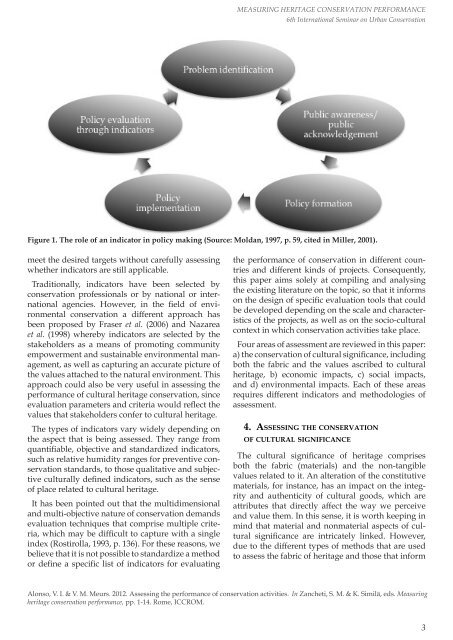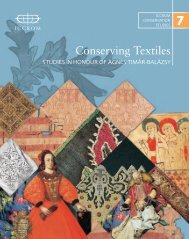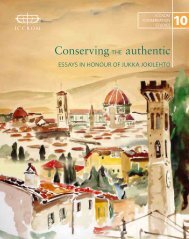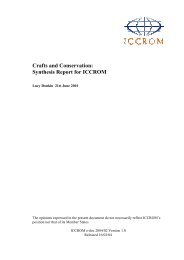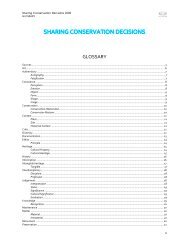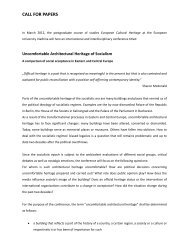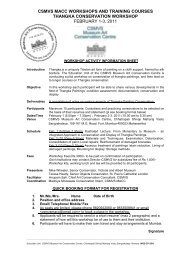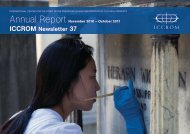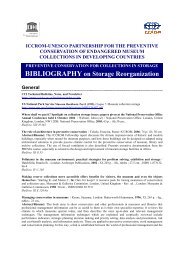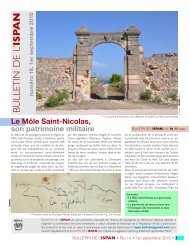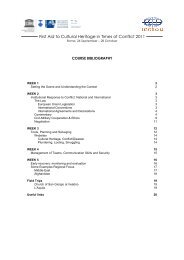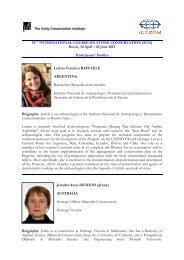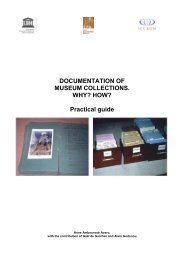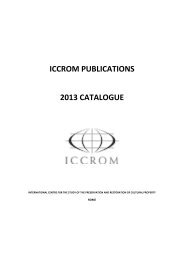part 1 - Iccrom
part 1 - Iccrom
part 1 - Iccrom
Create successful ePaper yourself
Turn your PDF publications into a flip-book with our unique Google optimized e-Paper software.
MEASURING HERITAGE CONSERVATION PERFORMANCE<br />
6th International Seminar on Urban Conservation<br />
Figure 1. The role of an indicator in policy making (Source: Moldan, 1997, p. 59, cited in Miller, 2001).<br />
meet the desired targets without carefully assessing<br />
whether indicators are still applicable.<br />
Traditionally, indicators have been selected by<br />
conservation professionals or by national or international<br />
agencies. However, in the field of environmental<br />
conservation a different approach has<br />
been proposed by Fraser et al. (2006) and Nazarea<br />
et al. (1998) whereby indicators are selected by the<br />
stakeholders as a means of promoting community<br />
empowerment and sustainable environmental management,<br />
as well as capturing an accurate picture of<br />
the values attached to the natural environment. This<br />
approach could also be very useful in assessing the<br />
performance of cultural heritage conservation, since<br />
evaluation parameters and criteria would reflect the<br />
values that stakeholders confer to cultural heritage.<br />
The types of indicators vary widely depending on<br />
the aspect that is being assessed. They range from<br />
quantifiable, objective and standardized indicators,<br />
such as relative humidity ranges for preventive conservation<br />
standards, to those qualitative and subjective<br />
culturally defined indicators, such as the sense<br />
of place related to cultural heritage.<br />
It has been pointed out that the multidimensional<br />
and multi-objective nature of conservation demands<br />
evaluation techniques that comprise multiple criteria,<br />
which may be difficult to capture with a single<br />
index (Rostirolla, 1993, p. 136). For these reasons, we<br />
believe that it is not possible to standardize a method<br />
or define a specific list of indicators for evaluating<br />
the performance of conservation in different countries<br />
and different kinds of projects. Consequently,<br />
this paper aims solely at compiling and analysing<br />
the existing literature on the topic, so that it informs<br />
on the design of specific evaluation tools that could<br />
be developed depending on the scale and characteristics<br />
of the projects, as well as on the socio-cultural<br />
context in which conservation activities take place.<br />
Four areas of assessment are reviewed in this paper:<br />
a) the conservation of cultural significance, including<br />
both the fabric and the values ascribed to cultural<br />
heritage, b) economic impacts, c) social impacts,<br />
and d) environmental impacts. Each of these areas<br />
requires different indicators and methodologies of<br />
assessment.<br />
4. Assessing the conservation<br />
of cultural significance<br />
The cultural significance of heritage comprises<br />
both the fabric (materials) and the non-tangible<br />
values related to it. An alteration of the constitutive<br />
materials, for instance, has an impact on the integrity<br />
and authenticity of cultural goods, which are<br />
attributes that directly affect the way we perceive<br />
and value them. In this sense, it is worth keeping in<br />
mind that material and nonmaterial aspects of cultural<br />
significance are intricately linked. However,<br />
due to the different types of methods that are used<br />
to assess the fabric of heritage and those that inform<br />
Alonso, V. I. & V. M. Meurs. 2012. Assessing the performance of conservation activities. In Zancheti, S. M. & K. Similä, eds. Measuring<br />
heritage conservation performance, pp. 1-14. Rome, ICCROM.<br />
3


